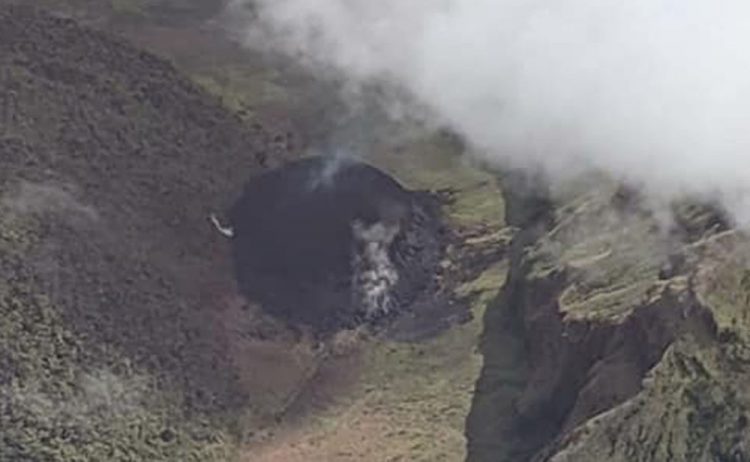Effusive eruptions taking place at La Soufriere, residents put on high alert

An effusive eruption is taking place at La Soufriere and residents of St Vincent and the Grenadines (SVG) have been placed on high alert.
Volcanologist Dr Richard Robertson, at a press briefing today said that on December 22, the University of the West Indies Seismic Research Centre (UWI-SRC) in Trinidad was made aware by the National Aeronautics and Space Administration (NASA) of a hot spot on La Soufriere.
That information from the NASA satellite further piqued their interest as according to Dr Erouscilla ‘Pat’ Joseph, director of the UWI-SRC, since early November, there has been an increase in the background level of seismic activity being recorded at La Soufriere.
“Generally events were one or two per day, sometimes none at all, but it was certainly sufficient for us to be a bit concerned and we have been liaising with the National Emergency Management Organization (NEMO) ever since, providing advisories as necessary,” Robertson told reporters via Zoom at the press briefing at Cabinet room in the presence of prime minster Dr Ralph Gonsalves and other officials.
Vincentians have now been placed on high alert as the UWI-SRC says the activity which is now being detected is above average and is something to be concerned about.
Robertson said the NASA image of the hot spot was “basically smack in the crater of the volcano…it wasn’t clear what was happening.”
“So NEMO, the Soufriere monitoring unit, arranged to go up today because there was a heat source at the summit that was not letting up for the last couple days,” the Vincentian volcanologist said.
He noted that earlier today, when the NEMO team went up, they verified that there is an emission and reported that there is currently an effusive eruption where magma is coming slowly out of the earth and building a dome-shaped, black mass of rock.
“We are currently working with NEMO to augment the monitoring system because at present what would happen once you have an eruption onset, we want to have a team and more instruments in so we can give direct advice to NEMO as it goes along,” Robertson explained.
The Government of Trinidad and Tobago has given permission for three staff members of the UWI-SRC, including Robertson, to travel to SVG tomorrow, Wednesday, bringing with them additional instruments to enable them to more closely monitor the volcano.
Robertson noted that the effusive type eruption that is happening now is similar to what happened during the 1971/1972 eruptions.
In an effusive eruption, magma oozes out of a volcanic vent and out into the surrounding area. This is different to an explosive eruption which is the type experienced by the country in 1979.
It cannot be predicted if and when a volcano’s eruptions will become explosive.
Robertson said the mass growing in the crater of the volcano is similar to the one that grew in 1971/1972.
“We have the same kind of mass growing on the side. As it is now, the mass is confined in the crater and because of the configuration of the crater, a lot of the hazard as it presently stands are in the crater itself.
“The rock is hot and you do not want to be close to it when it is growing, because think of it as a big truck dumping a set of stone but the stone is coming from below and the mass is growing and as it comes out it is bringing with it the gases…and the steam that you are seeing there is the gases that come out,” Robertson noted.
He said the gases are sulphur rich and when they mix with the atmosphere they are not going to cause much harm, but if you are on the crater’s rim it is going to be really difficult to breathe as some of the constituents of the gas is sulphur dioxide and hydrogen sulphide which is smelly, and can dry out a person’s airways.
He therefore advised persons to stay away from the volcano.
“We want to monitor the rate in which [the dome] is increasing in size because as it expands, one of the types of hazards is that it can spill over into the valleys and the closest lip it can spill over into is in the area of Larakai…,” Robertson warned.
While there is no evacuation notice at this time, Prime Minister Dr Ralph Gonsalves said residents north of Georgetown and Belle Isle should make plans to evacuate at short notice should that become necessary.









